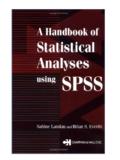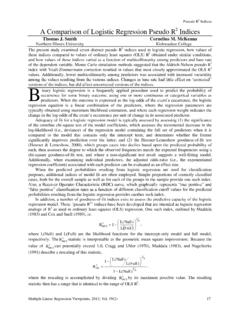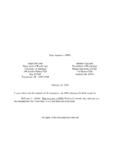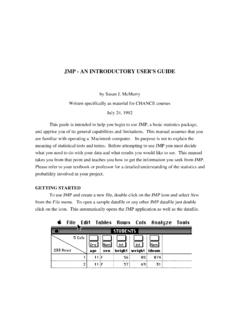Transcription of A very basic tutorial for performing linear mixed …
1 1 A very basic tutorial for performing linear mixed effects analyses ( tutorial 2) Bodo Winter1 University of California, Merced, Cognitive and Information Sciences Last updated: 01/19/2013; 08/13/2013; 04/18/2014; 05/19/2014 This tutorial serves as a quick boot camp to jump-start your own analyses with linear mixed effects models. This text is different from other introductions by being decidedly conceptual; I will focus on why you want to use mixed models and how you should use them. While many introductions to this topic can be very daunting to readers who lake the appropriate statistical background, this text is going to be a softer kind of so, don t panic!
2 The tutorial requires R so if you haven t installed it yet, go and get it! I also recommend reading tutorial 1 in this series before you go further. You can find it here: This tutorial will take you about 1 hour (possibly a bit more). 1 For updates and other tutorials , check my webpage If you have any suggestions, please write me an email: Please cite as: Winter, B. (2013). linear models and linear mixed effects models in R with linguistic applications. [ ] 2 Introduction: Fixed and random effects In tutorial 1, we talked about how we could use the linear model to express the relationships in our data in terms of a function.
3 In one example, we modeled pitch as a function of age. pitch ~ age + We called age a fixed effect, and was our error term to represent the deviations from our predictions due to random factors that we cannot control experimentally. You could call this part the probabilistic or stochastic part of the model. Now, we ll unpack this and add complexity to it. That is, we change the random aspect of our model, essentially leaving the systematic part unchanged. In mixed models, everything in the systematic part of your model works just like with linear models in tutorial 1.
4 In one of my studies, we have been interested in the relationship between pitch and politeness (Winter & Grawunder, 2012). So, essentially we re aiming for a relationship that looks like something like this: pitch ~ politeness + In our study, politeness was treated as a categorical factor with two a formal register and an informal register. On top of that, we also had an additional fixed effect, sex, and so our formula looks more like this: pitch ~ politeness + sex + So far so good. Now things get a little more complicated.
5 Our design was so that we took multiple measures per subject. That is, each subject gave multiple polite responses and multiple informal responses. If we go back to the discussion of the assumptions of the linear model in tutorial 1, we can immediately see that this would violate the independence assumption: Multiple responses from the same subject cannot be regarded as independent from each other. Every person has a slightly different voice pitch, and this is going to be an idiosyncratic factor that affects all responses from the same subject, thus rendering these different responses inter-dependent rather than independent.
6 The way we re going to deal with this situation is to add a random effect for subject. This allows us to resolve this non-independence by assuming a different baseline pitch value for each subject. So, subject 1 may have a mean voice pitch of 233 Hz across different utterances, and subject 2 may have a mean voice pitch of 210 Hz per subject. Here s a visual depiction of how this looks like: 3 F1F2F3F4F5F6F7F8F9M1M2M3M4M5M6M710015020 0250300350400 Mean Pitch (Hertz)Subjects Subjects F1 to F9 are female subjects. Subjects M1 to M7 are male subjects. You immediately see that males have lower voices than females (as is to be expected).
7 But on top of that, within the male and the female groups, you see lots of individual variation, with some people having relatively higher values for their sex and others having relatively lower values. We can model these individual differences by assuming different random intercepts for each subject. That is, each subject is assigned a different intercept value, and the mixed model estimates these intercepts for you. Now you begin to see why the mixed model is called a mixed model. The linear models that we considered so far have been fixed-effects-only models that had one or more fixed effects and a general error term.
8 With the linear model, we essentially divided the world into things that we somehow understand or that are somehow systematic (the fixed effects, or the explanatory variables); and things that we cannot control for or that we don t understand ( ). But crucially, this latter part, the unsystematic part of the model, did not have any interesting structure. We simply had a general across-the-board error term. In the mixed model, we add one or more random effects to our fixed effects. These random effects essentially give structure to the error term.
9 In the case of our model here, we add a random effect for subject , and this characterizes idiosyncratic variation that is due to individual differences. The mixture of fixed and random effects is what makes the mixed model a mixed model. 4 Our updated formula looks like this: pitch ~ politeness + sex + (1|subject) + (1|subject) looks a little enigmatic. I m already using the R-typical notation format here. What this is saying is assume an intercept that s different for each subject .. and 1 stands for the intercept here.
10 You can think of this formula as telling your model that it should expect that there s going to be multiple responses per subject, and these responses will depend on each subject s baseline level. This effectively resolves the non-independence that stems from having multiple responses by the same subject. Note that the formula still contains a general error term . This is necessary because even if we accounted for individual by-subject variation, there s still going to be random differences between different utterances from the same subject.









